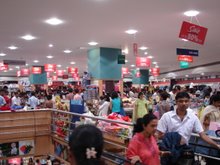India Has Been Unable To Create Youth Brands
We have had Thums Up, Titan, Karizma
NO. India has seen the creation of some great brands for the youth over the past few decades. Those of us who were in our teens in the late 70s and early 80s could hardly think of being ‘cool’ without a Thums Up in hand. The list is long and exciting: Lakme and Elle 18, launched by the Tatas for the teenybopper crowd; Titan Fast Track; Hero Honda’s Karizma and Bajaj Pulsar in two-wheelers, Limca, launched by the Parle Group and subsequently acquired by Coca Cola. Kingfisher from the UB Group stable has of course, acquired iconic proportions among youth within, and beyond, India. Another brand which is in the making is Café Coffee Day, signifying a great gathering place for youth. And why not? India is a young country with over 60% of the population being below 30 years of age. It is critical for companies to talk to the young. They are after all, very early adopters and must have their own brands. Brands like Thumps Up, Limca and Lakme — all of which were born in the 1970s as a result of visionary thinking of their founders — were created specifically to reflect the ‘Can-do’ attitude of young Indians. Each of them provided a wellrounded experience and transcended geographical borders in their appeal. The fact that some of them have been acquired by MNCs to bolster their portfolios is testimony to their enduring nature. The two-wheeler segment is arena that abounds with examples — be it TVS with its Scooty, Hero Honda with Karizma or Bajaj with Pulsar. All of them have created distinct positions in the youth’s mind. What each of them play up are styling and maneuverability. Catering to young college-going students — for whom this was often their first bike — they are also fuel efficient with easy financing options, keeping in mind limited budgets of their Target Audience. Karizma and Pulsar are for youngsters wanting to make a lifestyle statement — sleek and stylish with huge ‘flaunt’ value. Finally, there is no dearth of youth brands in the telecom sector, a sector that itself is relatively young. It is the country’s young who are the first adopters of telephony. Airtel keeps introducing for its young audiences offerings like its MTV Card and Magic. To sum up, the commonality in all youth brands is that they have delved into the mindset of the youth, gained distinct insights and tailor-made their offerings around them. This was then supplemented by great advertising, reaching out to the youth through youth channels. In addition, they were backed by 360 degree activation around youth agglomerations – college fests, multiplexes, concerts, and in recent times, reaching out using the new media like the internet. I therefore, rest my case that India and Indians have been very successful at creating youth brands.
The writer is director marketing, Nokia India
Maggi, Heinz, Puma are surely not local brands
Shailesh Chaturvedi , YES. The “Don’t ever use what Dad is using,” theme has always been at the heart of aspiration of the youth segment. In my college days in the late 80’s, we wore Proline Tshirts, Flying Machine Jeans (FU’s jeans were cooler still), Woodland rugged shoes and looked into Titan watches while waiting for girlfriends. Most of these Indian brands have, unfortunately, not kept pace with the times and have become papa’s brands while Nike/Tommy/Diesel continue to retain parts of their young appeal. Let’s cut to another age. My six-year-old son’s favourite brands are Maggi Noodles, Heinz ketchup, Puma shoes. There are hardly any Indian brands in his preference set (other than Haldiram Bhujia and Kaju Katli). In a decade from now, he will enter the youth segment with hardly any Indian brands in his preference set. When one analyses the trends of the last two decades, one realises that India has not been able to create or sustain youth brands. In my industry (apparel and lifestyle products), jeans and sneakers are two very important categories for the youth. Unfortunately, there are hardly any Indian brands in both these key categories. While Nike/Adidas/Reebok remain leading shoe brands with youth, Levi’s/Pepe/Giordano may be strong brands with youth in ‘popular priced jeans’ segment, while Diesel, CK or Tommy Jeans are the important jeans brands in the ‘aspirational’ jeans segment. There are no important Indian brands to talk about here. Reasons for inability of local brands to connect with youth segment, especially in India, may include the following:
The issue of sustainability:
Youth segment demands constant innovation. Many Indian brands like Proline, Titan, Woodlands, Flying Machine, Liberty shoes started with energy and unique ideas but most of them could not sustain the tempo and the youth brigade migrated to the latest brand on the horizon with the cooler attitude.
The fear of loss of existing core consumers:
As the existing core users of a brand start to age (‘Papa-isation’), their tastes start to change gradually. At the same time, the youth of the time may demand a complete new makeover.
The common language:
Tech-savvy youth endorse a common language in this information age. They follow the same role models, watch the same TV programmes and play with the same games on their wireless game consoles.
Older youth Icons in India:
In most polls on youth icons, one sees the names like Amitabh, SRK, and Sachin. They have already grown old. These idols favour more mature brands.
The writer is CEO, Tommy Hilfiger Apparel, India. These are the writer’s personal views and do not reflect the views of his organisation.




No comments:
Post a Comment